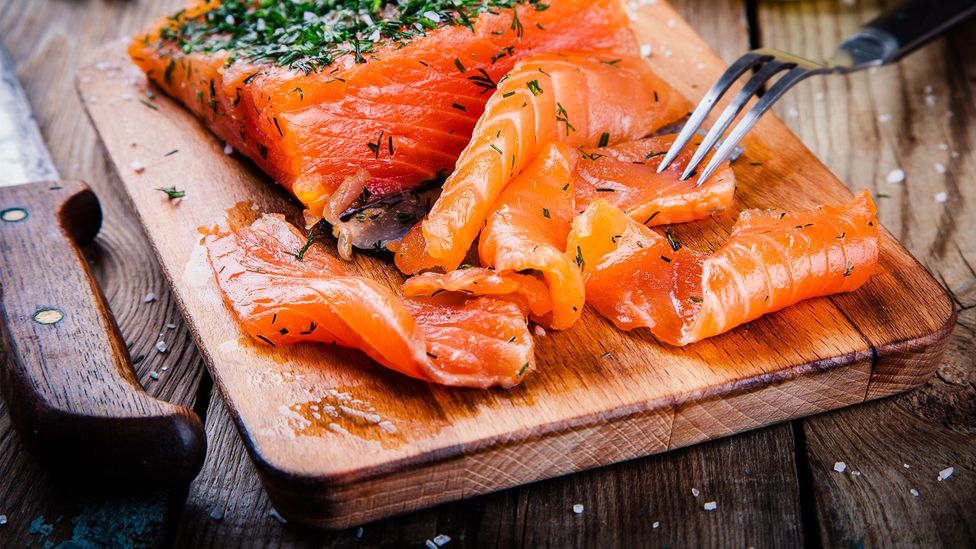Joe Baur
Lox (Yiddish for salmon) is a ubiquitous Jewish staple in New York City, often paired with a schmear of cream cheese on a bagel. The thinly sliced lox is salty and buttery with a subtle hint of smokiness that pairs beautifully with the soft tanginess of the cream cheese. Delicately prepared on top of a bagel – and sometimes topped with capers or red onion – it’s a wonderfully satisfying breakfast that’s hard to beat.
But it’s not the only way to get your salmon fix in the city. Another popular preparation for salmon is gravlax – salmon cured in salt and sugar – which author June Hersh features in her latest book, Iconic New York Jewish Food: A History and Guide with Recipes.
[jump to recipe]A born-and-bred New Yorker, Hersh dedicates her new book to her mother, whom she calls “a Bronx girl through and through”. “She was truly a New Yorker and grew up in an area of the South Bronx that was home to a lot of Jewish immigrants, her parents being two of them – one from Poland and one from Russia,” Hersh explained. “I think that imbued her with a sense of being grateful and appreciative of everything she ever had in life.”
Part of that gratitude was placed on food, something Hersh believes a lot of Jewish immigrant families had in common.
“They knew what it was like to go without and to not have everything so plentiful,” she said. “I think that that informed a lot of the decisions she made throughout her life and certainly throughout my childhood.”
Hersh has fond memories of eating pickled tongue with a baked potato and cream spinach on a typical Wednesday evening; finding a kind of Sephardic Greek lasagne made with matzo and a spicy tomato sauce on the table at Passover; and franks and beans made from kosher hot dogs that were fat and juicy. Her Russian-born grandmother made chopped liver, stuffed cabbage and apple cake, and there was “the mandatory bowl of matzo ball soup on every holiday table” with deliciously dense matzo balls.
“My home was filled with those Jewish specialties,” said Hersh. “I think you develop a taste for them, and once they grab hold, those are hard to let go of.”
The appetizing store, specialising in fish and dairy, is one of the many homes for Jewish flavours. Hersh explained that the term “appetizing” never existed until Jewish immigrants came to New York City in the late 19th and early 20th Centuries. “It really developed from the concept of a Yiddish word forshpeis, which were the little starters that you would eat at dinner,” she said. “They had to be pickled and smoked fish and things like that.”
In the early 1900s, “appetizing” turned from an adjective into a noun, and from a concept to brick-and-mortar stores. Lox, a derivative from the Norwegian word for salmon, laks, was front and centre at the appetizing store. Also called “belly lox” (as it’s from the belly of the fish), it was what Hersh ate as a child. “It’s delicious, but unbelievably salty,” she said, because of the amount of salt used to cure the fish.
However, Jewish communities of Poland prior to World War Two brought the tradition of smokehouses to New York City. They would take that salty, cured salmon (belly lox) and smoke it. This, Hersh explained, was dubbed “nova” (so named because the fish came from the waters of Nova Scotia). “That’s what we eat today,” she said. “Most people, when they go into [an appetizing] store and they say, ‘I’d like some lox,’ they mean they want nova.”
But in her latest book, Hersh turns our attention to gravlax – a Scandinavia style of cured salmon with roots in the history of New York City that stretch just as deep as lox.
“Gravlax pretty much connects us back to that original product that was eaten in New York in the early 1900s,” said Hersh, who first came across it around the 1970s when Norwegian influences became more popular in New York. “What the Norwegians do […] is make a combination of salt and sugar and they cure the lox with that combination.”
Hersh explained that some appetizing stores offered it as a way to modernise and add a bit of elegance to a food considered to be more Old-World Jewish. “It became an updated way to enjoy salmon, a nod to the past with a more modern and refined flavour,” said Hersh. “The subtle flavour and silky texture of gravlax make it a salmon for the 21st Century.”
Hersh favours putting a bit of vodka on her gravlax to add a nuanced flavour and to help the salt and sugar dissolve. Then, she layers it with herbs.
“You can infuse it with any flavour you want,” she said. “I usually use dill or a combination of dill and basil and then sandwich the two pieces of salmon, let it sit, and cure.” The end result is homemade gravlax, a different animal from the nova at appetizing stores today because it hasn’t been smoked.
And unlike the lox you might order at a bagel shop, you wouldn’t smother this with a layer of cream cheese. Rather, gravlax sits gracefully on top of a blini (a kind of Eastern European pancake) or latke (potato pancake), used as a garnish with a little crème fraiche or sour cream.
Hersh recommends slicing gravlax at a forty-five-degree angle (Credit: wmaster890/Getty Images)
Homemade Gravlax recipe
By June Hersh
Yields 900g (2lb) of gravlax
Method
Step 1
Have your fishmonger cut two pieces of salmon that match up so that you can lay one on top of the other.
Step 2
Cover a portion of your counter with enough plastic wrap to lay the salmon pieces down and then wrap them up. Place the salmon side by side, skin side down on the wrap.
Step 3
Drizzle each piece with 1tbsp of chilled vodka. Mix the salt and sugar and sprinkle both pieces with the mixture. Season with freshly cracked black pepper. Lay enough dill and basil to cover the entire surface of both pieces. Using the plastic wrap as an aid, lay one piece of salmon over the other and tightly wrap the salmon pieces so the meaty sides firmly adhere to each other. Take another piece of wrap and continue to seal the package.
Step 4
Place the package in a shallow dish and lay a plate or small pan on top of the salmon. Place several cans or a heavy item on top of the pan or plate to weigh down and press the fish. Place the dish in the fridge, turning the salmon over every 12 hours for 2 to 3 days. The longer the cure, the drier the finished fish and more intense the flavour.
Step 5
Remove the salmon from the fridge, discard all the herbs and lightly rinse. Pat dry. Using a very sharp long knife, begin slicing the salmon at a forty-five-degree angle, being sure to not cut through the skin (since you don’t want skin on the slices). Serve the sliced gravlax on top of a blini or latke. A dollop of crème fraiche, sour cream or tzatziki adds a nice touch, especially when spiked with grated cucumber or dill. The salmon will hold for up to 5 days, tightly wrapped, in your fridge, but I bet it will be gobbled up long before that.
Courtesy: BBC







